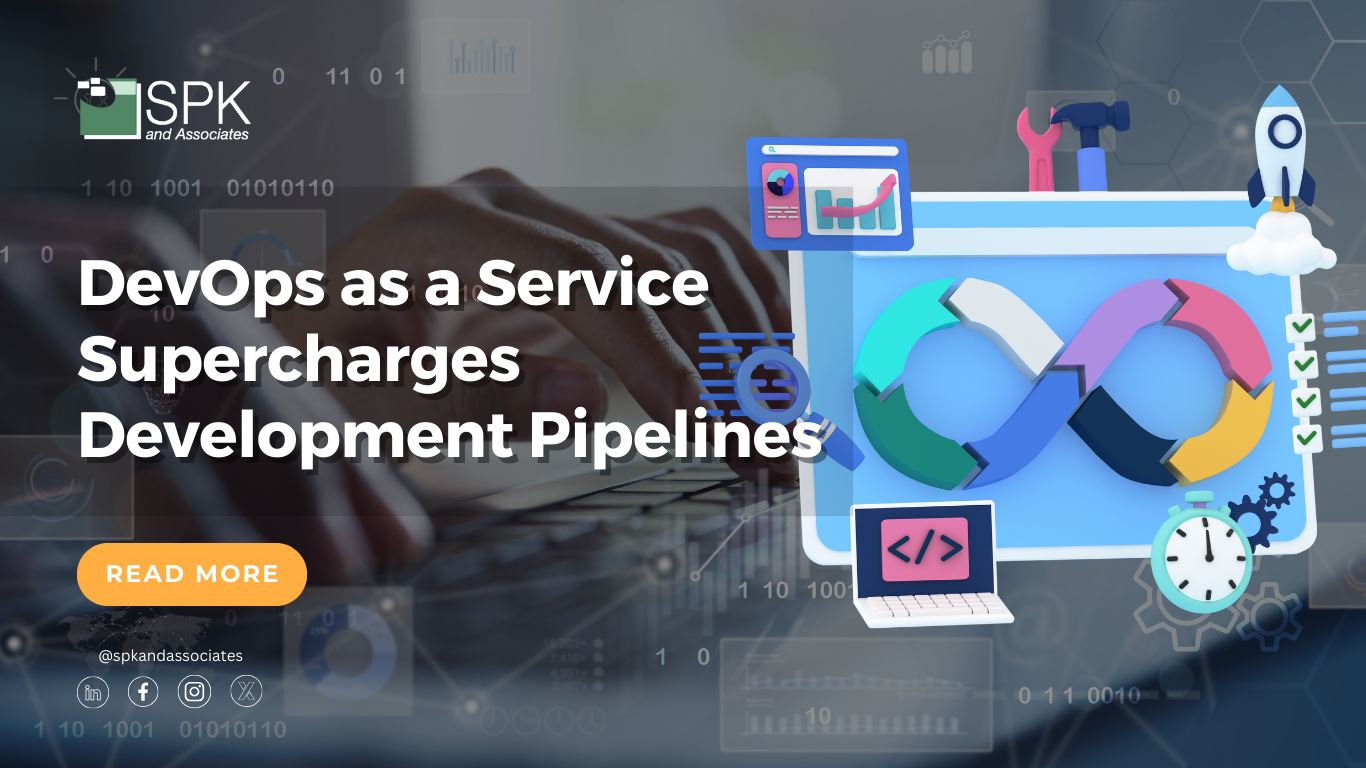It seems like just about every company is now a part-time or full-time software company. But, for small and mid sized companies, employing effective practices, such as DevOps to manage the day-to-day, might not be feasible. However, there is a solution. It’s called DevOps as a service (DOaaS). Let’s explore how DOaaS can supercharge your development pipelines, making your operations more efficient, cost-effective, and aligned with your business goals.
What Is DevOps As A Service (DOaaS)?
Most products have a digital component, and with that comes software.
Furthermore, each company with software products wants to get their product to market – fast. So, they need to develop efficient software development and deployment practices. I like to call this the “software factory.” Similarly to physical products, software also has a factory. It is made up of people, processes, and technology. Additionally, these factors must work together harmoniously like an orchestra.
What Is DevOps As A Service (DOaaS)?
Most products have a digital component, and with that comes software.
Furthermore, each company with software products wants to get their product to market – fast. So, they need to develop efficient software development and deployment practices. I like to call this the “software factory.” Similarly to physical products, software also has a factory. It is made up of people, processes, and technology. Additionally, these factors must work together harmoniously like an orchestra.

This is where DevOps plays a pivotal role.
- DevOps is a set of practices that combines software development (Dev) and IT operations (Ops).
- Plus, it aims to shorten the development lifecycle and provide continuous delivery with high software quality. It does this by harmonizing and integrating development and operations roles.
- The goal is a streamlined, smoothly functioning software factory.
However, for small and mid-size companies, the challenge of establishing and maintaining a well-oiled, in-house DevOps team can be daunting. The same is true for product companies where software is only a piece of the product. Why? Firstly, there is an array of technical skill sets necessary that are difficult to find in a few people. And, the smaller software factory:
a.
Cannot afford this luxury,
b.
Doesn’t need a team of full-time people that are required to produce an effective DevOps function.
This is where DevOps-as-a-Service (DOaaS) becomes a game-changer. It offers a solution encapsulating all the benefits of DevOps without the complexity and cost of managing it in-house. At SPK and Associates, we have seen this over and over with our clients. And, that’s why we’re sharing how you can utilize DOaaS.
The DevOps Dilemma For Small And Mid-size Teams
The real work that a smaller software team should focus on – the critical capability they bring to the table – is the understanding of their:
Customers
Products
Design
And, their development into functioning code. In other words – the creative process.
Expertise Requirements
DevOps requires a blend of software development and IT operations skills (emphasis on operations). Essentially, you’re not looking for a software developer doing this side of the desk. Firstly, DevOps professionals are more process-driven and aware. They have different technical skills – an operational versus creative focus. In our own experience, we have tried to place people with software development “personas” in DevOps roles, with rare success. In fact, the DevOps role attracts a different mindset.
Now, let’s switch focus from personality to technical needs.
Even for small teams, there is a daunting technology stack that needs expertise to run. We can use the following excerpt from a sample RACI chart to consider a short list of the DevOps roles needed by small software teams.
For smaller companies or teams, it would be impossible to hire for these needs in-house. Equally, these skill sets are not all found in one person. Plus, the skill sets are not needed full time. So, the optimal answer is a team of talented individuals delivering their needed service to the software factory at the right times.
The Challenges of Technology Choices and Maintenance
Besides the people and processes, DevOps also requires the right tools. There are many, many ways to construct a software factory – different tools integrated together, one platform that orchestrates everything, and so on. For optimal efficiency, new or adaptable software teams should choose the DOaaS team’s platform when starting or exploring new tech stacks. DevOps as a service enables:
- An optimal DevOps platform (or factory) to be built without unnecessary cost.
- Assembly lines functioning well.
- All the automation is in place.
- The designers/software developers/QA staff are trained in the technology and processes.

Ultimately, it’s a well-oiled machine waiting to be tapped into.
But this isn’t always feasible, particularly if the software team is established and already functioning. In such cases, the DOaaS team folds into the existing factory. And, it begins to streamline and automate it incrementally.
Furthermore, the DevOps technology landscape is continuously evolving. That means, staying up-to-date with the latest trends, tools, and best practices requires constant vigilance and adaptation. So, having a dedicated team doing that is a huge advantage large software teams have. And, smaller teams can enjoy DOaaS.
Scalability Issues
But, what about business growth? Yes, DevOps needs change too. Consequently, scaling an in-house DevOps team to match business growth can be complicated, and drain resources. Plus, it requires not just hiring more staff but also ensuring the infrastructure and processes are scalable and efficient. This scalability challenge can become a bottleneck for growth. This is particularly true for companies experiencing rapid expansion.
Strategic and Practical Advantages of DevOps as a Service
DOaaS provides a host of advantages to smaller software teams, otherwise exclusive to larger teams.
Cost Efficiency
With DOaaS high costs of recruiting, training, and maintaining an in-house team become a fraction of the price. So too does the necessary infrastructure and tools. Plus, companies can access state-of-the-art DevOps services at a fraction of the cost, in a pay-as-you-go model.
Expertise-on-Demand
Companies gain access to a pool of experts with a broad range of skills and experience, keeping abreast of the latest developments.
Scalability and Flexibility
Whether a team is launching a new product, scaling or dialing back operations, DOaaS adjusts quickly and efficiently to changing demands.
Focus on Core Business
By outsourcing DevOps to DOaaS, companies can focus on their core business activities. And, they can do so without being sidetracked by the complexities of managing a software factory.
Faster Deployment Cycles
Next, companies can significantly shorten their software development and deployment cycles with DOaaS. Essentially, the integration of advanced automation tools and streamlined processes ensures rapid and consistent releases.
Improved Quality and Reliability
Continuous monitoring and proactive maintenance also ensure any issues are identified and resolved swiftly. Therefore, this maintains the reliability and performance of applications.
Continuous Integration and Delivery
Lastly, one of the cornerstones of DevOps is continuous integration and delivery (CI/CD). DOaaS ensures these practices are implemented efficiently, allowing for frequent and automated updates to applications.
Practical Examples
SPK has helped a wide range of companies with DOaaS. Our clients have included startups to midsize teams, purely software to mechatronic products, unregulated and regulated environments. And, all have benefited from DOaas.
The typical example, though, is a small software team. We have recently been working with a software startup developing a cloud-native application on AWS. When we joined in, they had front-end and back-end developers, designers, a scrum master/project manager, and a QA team. Sounds like they should have been set, right? But even with talented staff, the factory wasn’t working well. Basically there was a lot of manual intervention required and process confusion. That meant they were only able to release once every couple weeks, and errors were common.
SPK introduced DevOps as a service team with skill sets in:
- AWS
- Terraform
- Atlassian Jira and Bitbucket
- Elastic Beanstalk
- Cybersecurity
- Compliance, and more.
Firstly, we documented the entire process. Then we began streamlining the Jira boards, improving the CI/CD pipelines, codifying the infrastructure in Terraform. Gradually we removed the operational tasks from the developers, freeing them up to code more. So, what was the result? Happier software developers, nightly releases, fewer software bugs, and a faster lifecycle. All this at the cost of a part-time engineer.

Conclusion
DevOps as a service is a fantastic way for small and mid-sized companies to capitalize on state-of-the art DevOps processes and expertise. Plus with DOaaS, you pay a fraction of the cost for the same optimal outcomes.
If you want to discuss how DOaaS can transform your business, our team is ready to help. Contact us to learn more.






